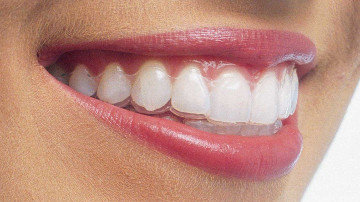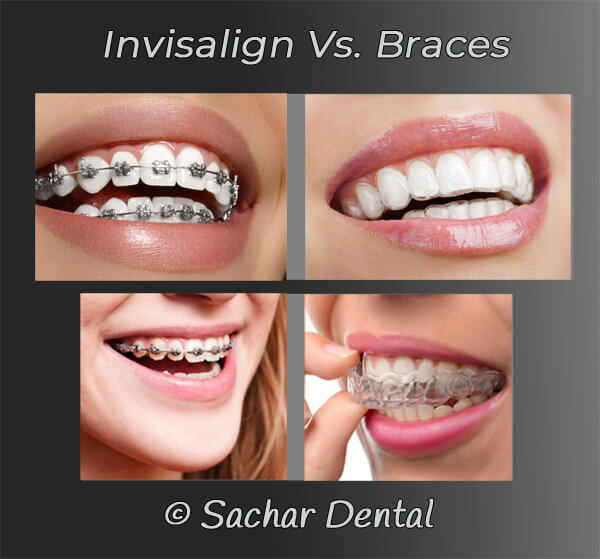The Expense of Invisalign: Recognizing the Investment in Your Smile
The Expense of Invisalign: Recognizing the Investment in Your Smile
Blog Article
Invisalign vs. Standard Dental braces: Which Choice Is Right for You?
When thinking about orthodontic treatment, the option in between Invisalign and typical dental braces presents a number of essential aspects that warrant cautious assessment. Invisalign supplies a discreet alternative with removable aligners, while standard braces provide a more noticeable yet reliable service for extreme imbalance. Each alternative incorporates distinctive benefits and drawbacks associated with looks, convenience, therapy duration, and price. Recognizing these subtleties is critical for making an educated decision that aligns with your individual choices and way of living. The concern stays: which alternative will finest meet your orthodontic needs and expectations?
Summary of Therapy Choices

On the other hand, standard braces include metal braces and wires that are bound to the teeth. This approach uses constant stress gradually to achieve alignment. While efficient for complex orthodontic problems, traditional dental braces call for normal gos to for changes and can posture challenges in maintaining oral hygiene as a result of the trouble of cleaning up about braces and cables.
Both options have their advantages, and the selection frequently hinges on specific oral conditions, lifestyle choices, and patient compliance. Ultimately, seeking advice from an orthodontic professional is crucial for identifying one of the most suitable therapy strategy tailored to individual needs. Recognizing the nuances of each alternative can substantially influence the overall success of orthodontic therapy.
Aesthetic Factors To Consider
A significant element affecting the selection between Invisalign and standard dental braces is the aesthetic appeal each treatment uses. Invisalign aligners are crafted from clear plastic, making them essentially unseen when used. This discreet look is especially attracting young adults and adults that may really feel uneasy regarding their orthodontic therapy. The capacity to preserve an all-natural smile throughout the positioning process can substantially boost the person's confidence in social and specialist settings.
On the other hand, standard dental braces consist of metal braces and cables, which can be more recognizable. While advancements in orthodontic technology have actually resulted in the growth of smaller brackets and colored elastics, traditional braces still maintain a more conspicuous profile. For some people, the exposure of braces might prevent them from seeking essential treatment.
Inevitably, the option in between Invisalign and traditional braces might rest on personal preferences relating to visual appeals. Patients who focus on discretion typically lean toward Invisalign, while those who are much less worried regarding exposure might go with conventional dental braces. Comprehending the visual effects of each alternative is crucial for making an educated choice that lines up with one's lifestyle and preferences.
Convenience and Convenience

In terms of benefit, Invisalign aligners are removable, enabling clients to enjoy their preferred foods without restriction and maintain optimum oral health. Cleaning and flossing are simplified, as the aligners can be gotten during these regimens, whereas standard braces require cautious maneuvering around braces and cords.
In comparison, typical dental braces necessitate normal changes, making them much less practical for those with active timetables. Generally, the comfort and benefit of Invisalign make it an enticing choice for lots of people seeking orthodontic therapy.
Treatment Duration and Effectiveness
While both Invisalign and standard dental braces are efficient in dealing with oral imbalances, the duration of treatment can vary considerably between the two options. Typically, Invisalign therapy can take anywhere from 12 to 18 months, depending on the complexity of the case. The clear aligners function by progressively changing teeth into their desired placements, and More Help regular follow-ups with an orthodontist aid make sure development continues to be on the right track.
On the other hand, traditional dental braces usually call for a longer commitment, generally ranging from 18 months to 3 years. This is due to their fixed nature and making use of cables and brackets, which can be extra effective for serious misalignments and complex instances (Invisalign). The treatment performance of traditional braces is well-documented, as they enable precise modifications and greater control over tooth activity
Eventually, the selection in between Invisalign and standard braces may depend upon both the expected treatment duration and the details dental problems at hand. Consulting with an orthodontist is crucial, as they can supply tailored recommendations based on individual demands, making sure the chosen method straightens with desired durations and end results.
Expense Comparison and Insurance Policy Options
Cost plays a substantial duty in the decision-making process for people considering orthodontic therapy, whether choosing for Invisalign or conventional braces. On average, the cost of Invisalign arrays from $3,000 to $8,000, while typical dental braces generally cost between $2,000 and $6,000. Variables affecting these costs consist of the intricacy of the instance, the duration of treatment, and geographical place.
Lots of dental insurance strategies offer partial coverage for orthodontic therapies, however the specifics can vary widely. Typically, typical braces may be much more often covered by insurance policy plans compared to Invisalign, which some insurers categorize as an aesthetic treatment.
Furthermore, numerous orthodontic methods offer versatile payment strategies, making both treatment alternatives a lot more easily accessible. Patients must inquire concerning potential financing options and discounts for in advance payments. Assessing the complete cost, including insurance policy benefits and layaway plan, is necessary for making an educated decision that lines up with both aesthetic preferences and budget plan factors to consider.

Conclusion
In summary, the selection between Invisalign and traditional braces rests on multiple aspects, including aesthetic choices, convenience, therapy duration, and cost. Invisalign provides a very discreet, detachable option that assists in dental hygiene and dietary versatility, while typical dental braces might be preferable for complicated dental issues and commonly come with a lower cost point. Ultimately, examination with an this orthodontist is important to analyze specific conditions and establish one of the most suitable treatment option for attaining ideal oral placement.
When thinking about orthodontic therapy, the option between Invisalign and conventional braces offers several crucial factors that warrant careful additional reading analysis.Contrasting Invisalign and conventional dental braces exposes distinct therapy options for orthodontic improvement.While both Invisalign and traditional braces are efficient in correcting oral imbalances, the duration of therapy can differ substantially in between the two choices.Cost plays a considerable duty in the decision-making process for individuals taking into consideration orthodontic treatment, whether choosing for Invisalign or traditional braces.In summary, the choice between Invisalign and standard braces hinges on several elements, including aesthetic preferences, comfort, therapy period, and cost.
Report this page